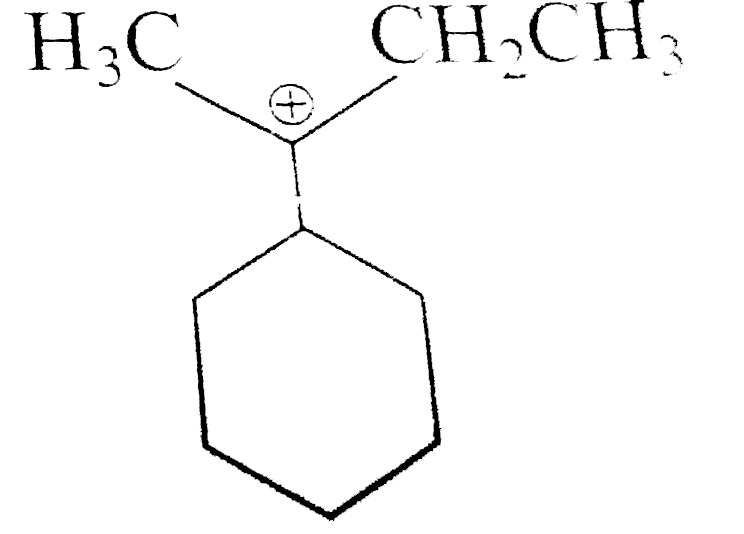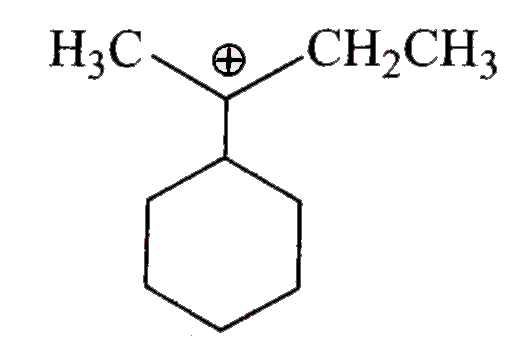The total number of contributing structures for hyperconjugation in propene is
3
4
5
2
The correct Answer is:B
To find the total number of contributing structures for hyperconjugation in propene, we can follow these steps:
1. Identify the Structure of Propene:
Propene has the molecular formula C₃H₆ and its structure can be represented as:
CH2=CH−CH3
In this structure, we have a double bond between the first two carbon atoms.
2. Identify the Hybridization:
- The first carbon (C1) and the second carbon (C2) are sp² hybridized.
- The third carbon (C3) is sp³ hybridized.
3. Identify Alpha-Hydrogens:
- Alpha-hydrogens are the hydrogens attached to the carbon atoms adjacent to the double bond (sp² hybridized carbons).
- In propene, the alpha-hydrogens are those attached to C1 and C2.
- C1 has 2 alpha-hydrogens (attached to C1) and C2 has 1 alpha-hydrogen (attached to C2).
- Therefore, the total number of alpha-hydrogens = 2 (from C1) + 1 (from C2) = 3.
4. Calculate the Number of Contributing Structures:
- The total number of contributing structures for hyperconjugation can be calculated using the formula:
Number of hyperconjugation structures=Number of alpha-hydrogens+1
- Substituting the number of alpha-hydrogens:
Number of hyperconjugation structures=3+1=4
5. Conclusion:
The total number of contributing structures for hyperconjugation in propene is 4.
Propene has the molecular formula C₃H₆ and its structure can be represented as:
CH2=CH−CH3
In this structure, we have a double bond between the first two carbon atoms.
- The first carbon (C1) and the second carbon (C2) are sp² hybridized.
- The third carbon (C3) is sp³ hybridized.
- Alpha-hydrogens are the hydrogens attached to the carbon atoms adjacent to the double bond (sp² hybridized carbons).
- In propene, the alpha-hydrogens are those attached to C1 and C2.
- C1 has 2 alpha-hydrogens (attached to C1) and C2 has 1 alpha-hydrogen (attached to C2).
- Therefore, the total number of alpha-hydrogens = 2 (from C1) + 1 (from C2) = 3.
- The total number of contributing structures for hyperconjugation can be calculated using the formula:
Number of hyperconjugation structures=Number of alpha-hydrogens+1
- Substituting the number of alpha-hydrogens:
Number of hyperconjugation structures=3+1=4
The total number of contributing structures for hyperconjugation in propene is 4.
Topper's Solved these Questions
- GENERAL ORGANIC CHEMISTRYBOOK - R SHARMACHAPTER - GENERAL ORGANIC CHEMISTRYEXERCISE - Follow- up Test 9
6 Videos
- GENERAL ORGANIC CHEMISTRYBOOK - R SHARMACHAPTER - GENERAL ORGANIC CHEMISTRYEXERCISE - Question bank Level - I
1 Videos
- GENERAL ORGANIC CHEMISTRYBOOK - R SHARMACHAPTER - GENERAL ORGANIC CHEMISTRYEXERCISE - Follow- up Test 7
11 Videos
- EQUILIBRIUMBOOK - R SHARMACHAPTER - EQUILIBRIUMEXERCISE - ARCHIVES
69 Videos
- ISOMERISMBOOK - R SHARMACHAPTER - ISOMERISMEXERCISE - Archives
11 Videos
Similar Questions
Knowledge Check
Hyperconjugation is
Aσ−π conjugationBnoticed due to delocalisation of σandπ bondCno bond resonanceDall the aboveThe number of hyperconjugating structures shown by the carbocations are given below. Which one is not correctly matched?
ACH3−+C∣CH3−CH3−9 hyperconjugating structuresBCH3−+CH−CH3−8 hyperconjugating structuresCCH3−+CH2−3 hyperconjugating structuresD+CH3−No hyperconjugating structuresThe number of hyperconjugating structures shown by the carbocations are given below. Which one is not correctly matched?
ACH3−+C | CH3−CH3, 9 hyperconjugatingBCH3−+C−CH3, 8 hyperconjugating structuresCCH3−+CH2, 3 hyperconjugating structuresD+CH3, No hyperconjugating structures
The total number of contributing structures showing hyperconjugation (involving C−H bonds) for the following carbocation is:

View SolutionHyperconjugation describes the orbital interactions between the π-system and the adjacent σ-bond of the substituent group(s) in organic compounds. Hyperconjugation is called as Baker and Nathan effect. The necessary and sufficient conditions for the hyperconjugation are:
(i) Compound should have at least one sp2-hybrid carbon of either alkene, carbocation or alkyl free radical.
(ii) α-carbon with respect to sp2 -hybrid carbon should have at least one hydrogen.
Hyperconjugation are of three types:
(i) σ(C−H),π-conjugation,
(ii) σ(C−H), positive charge conjugation,
(iii) σ(C−H), odd electron conjugation.
The hyperconjugation may be represented as,


Number of resonating structures due to hyperconjugation =(n+1), where n is the numebr of α-hydrogen. Greater is the number of such forms, more is the stability of the species under consideration.
Which of the following alkenes will show maximum number of hyperconjugation forms?
View SolutionHyperconjugation describes the orbital interactions between the π-system and the adjacent σ-bond of the substituent group(s) in organic compounds. Hyperconjugation is called as Baker and Nathan effect. The necessary and sufficient conditions for the hyperconjugation are:
(i) Compound should have at least one sp2-hybrid carbon of either alkene, carbocation or alkyl free radical.
(ii) α-carbon with respect to sp2 -hybrid carbon should have at least one hydrogen.
Hyperconjugation are of three types:
(i) σ(C−H),π-conjugation,
(ii) σ(C−H), positive charge conjugation,
(iii) σ(C−H), odd electron conjugation.
The hyperconjugation may be represented as,


Number of resonating structures due to hyperconjugation =(n+1), where n is the numebr of α-hydrogen. Greater is the number of such forms, more is the stability of the species under consideration.
Which of the following carbocations will show highest number of hyperconjugative forms?
View SolutionTotal number of resonating structures in the following compound is

View SolutionPhenate ion has more number of contributing structures than benzoate ion, but still benzoic acid is a stronger acid. Explain.
View Solution

